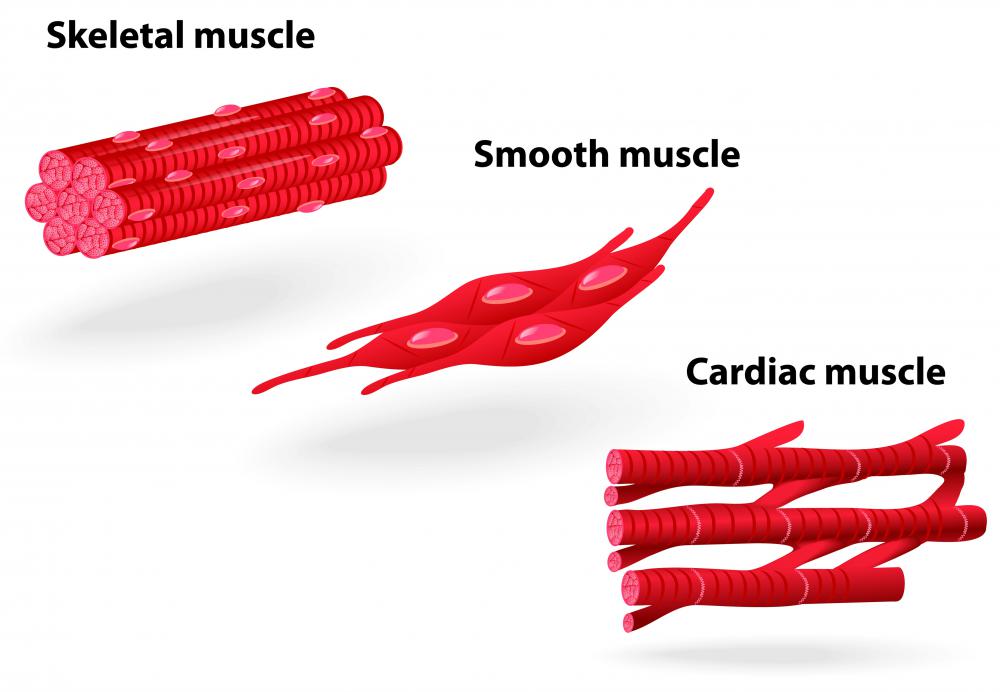At WiseGEEK, we're committed to delivering accurate, trustworthy information. Our expert-authored content is rigorously fact-checked and sourced from credible authorities. Discover how we uphold the highest standards in providing you with reliable knowledge.
What Is the Difference between Cardiac and Skeletal Muscles?
Cardiac and skeletal muscles are two major types that can be found in the body. Skeletal muscle is usually linked to bones by structures called tendons, while the cardiac variety is generally found only in the heart. While there are some similarities in structure, the two types of muscle typically differ in the arrangement of cells. Skeletal muscle cells are usually arranged into cylindrical fibers with multiple nuclei, and can be directly controlled by voluntary nerve signals from the somatic nervous system. Typically spindle-shaped, heart muscle cells are normally shorter in comparison and are linked via gap junctions, which allow compounds to pass directly from one to another.
The muscles in the heart can contract in response to signals from the organ’s own neural conduction system. Discharges can increase or decrease, and there are typically just brief periods of rests between beats. Cellular structures called mitochondria are larger and more numerous in heart cells that in muscle fibers. Heart cells can synthesize much more adenosine triphosphate (ATP) for energy. They can also convert lactic acid made by skeletal muscles into ATP, which is produced when they are deoxygenated; if cardiac muscle were to go into this state, it could be damaged.

Both cardiac and skeletal muscles have t-tubules, which help to conduct electrical action potentials. These typically serve to trigger calcium flow so that a muscle can contract. While there are generally more t-tubules in skeletal fibers, the ones making up cardiac muscles are wider than the skeletal types. Cardiac and skeletal muscles also differ in that fibers in the heart are linked via intercalated disks, which can also help synchronize contractions. In skeletal muscle fibers, the t-tubules and structures called Z-disks are generally the predominant connection points.

A common trait to both types of muscles is that they have a striated structure. This structure typically has thick, thin, and elastic filaments that make up the working part of the muscle called sarcomeres. The bands are usually slightly different in color from one another and often vary in density; the thick and thin filaments can interact because they are normally connected by cross bridges. Interactions between these and ATP generally enable muscles to contract.

Although the striated structure is common to cardiac and skeletal muscles, heart cells can be branched. The two types of muscle are usually characterized by how they look under a microscope. Characteristics of cells, like with many other tissues in the body, are typically analyzed by scientists, researchers, and physicians to identify each type and tell apart normal from diseased samples.
AS FEATURED ON:
AS FEATURED ON:
















Discussion Comments
The cardiac muscles are the marathon muscles, constantly working at a steady pace throughout a person's life. We cannot afford for them to tire as our skeletal muscles do from time to time. If a skeletal muscles cramps or needs a rest it is not a life threatening situation. Now imagine a cramping cardiac muscle or a heart muscle that just needs to rest for a couple hours every so often.
I found it interesting that the muscles associated with the heart are actually different in design than the skeletal muscles. I thought cardiac and skeletal muscles were the same other than where they are located.
Post your comments